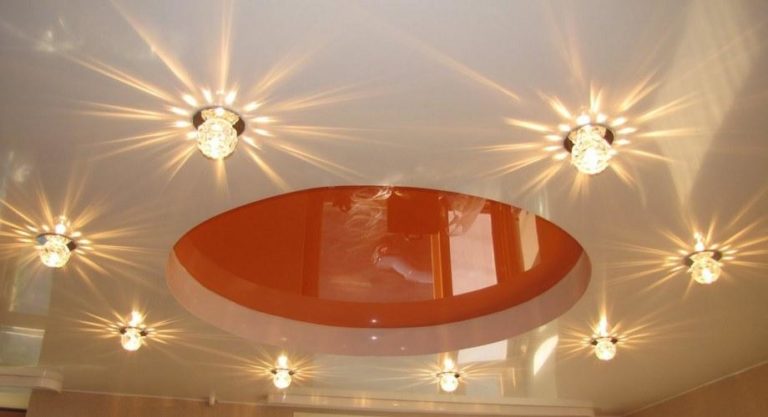How to properly install a light fixture in a slatted ceiling
A grid ceiling is a metal frame, fixed to the ceiling structure, and trimmed with narrow strips of plastic, aluminium or steel from below. Wooden laths are also used, i.e. standard battens. It is essentially a type of suspended ceiling.
Slatted ceilings can be of the open type, when the slats are spaced apart, or of the closed type, when the slats are fixed closely one to another. It is important even before the arrangement of a lath frame to decide on the lighting of such a design, what kind of suitable lamps and how to install them.
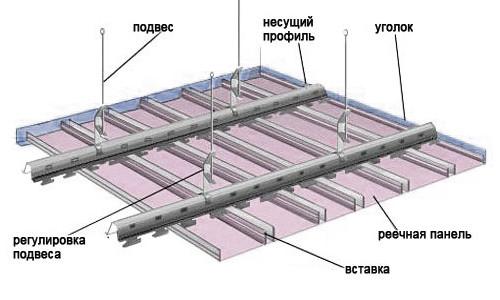
Luminaires for a grid ceiling
A variety of types and types of lighting fixturesDepending on the design of the frame, the type of panels and the characteristics of a particular lamp.
LED .
LEDs are economical in power and durable in use. This is especially beneficial to the family budget when you need to place a large number of LED spots.
They are not affected by voltage fluctuations, they do not heat the environment, they are not afraid of high humidity and they look aesthetically pleasing. All of these factors increase the possibilities of using LED elements for slatted structures in different rooms.
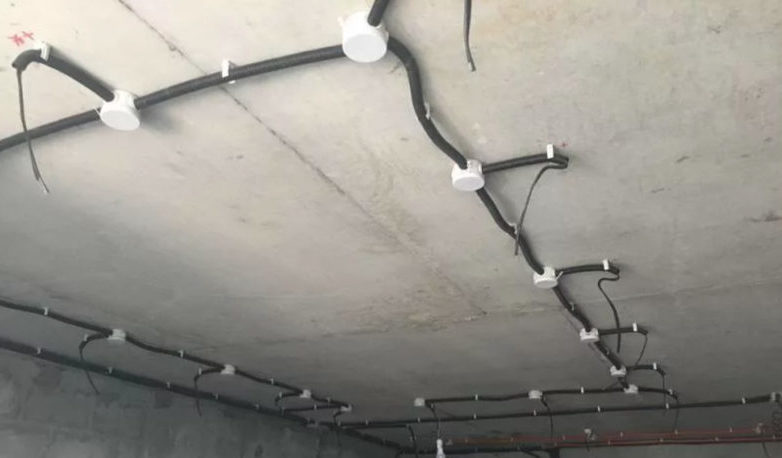
Fluorescent
Give a uniform and at the same time bright and calm light. Therefore they are well suited for decorating large premises where people are present for long periods - production halls, large offices, shopping centers.
They are energy efficient and resistant resistant to high humidity, making them ideal for installation in kitchens and bathrooms.
Spotlights
In slatted ceilings, spotlights, in addition to lighting, also serve as an original decorative design. It is important that they can set and at any time change the direction of light streams.
They come in different shapes and sizes, can serve as basic and supplementary lighting, to give different shades of radiation. With all these qualities, they have earned great popularity in use on slatted ceilings.
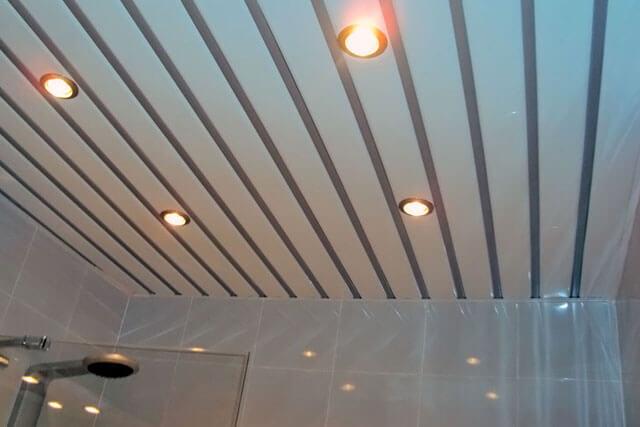
Recessed lights
The most suitable for installation on slatted ceilings are built-in spot models and grid designs. Depending on the type and size of the model, its installation can take place simultaneously with the installation of the ceiling or after.
In each case, before starting the work, it is necessary to determine the places in the suspended ceiling where there will be holes for lamps or lamp housings. It is necessary to make a marking for the exact places of installation of individual light modules, as well as a general scheme of arrangement throughout the ceiling area.
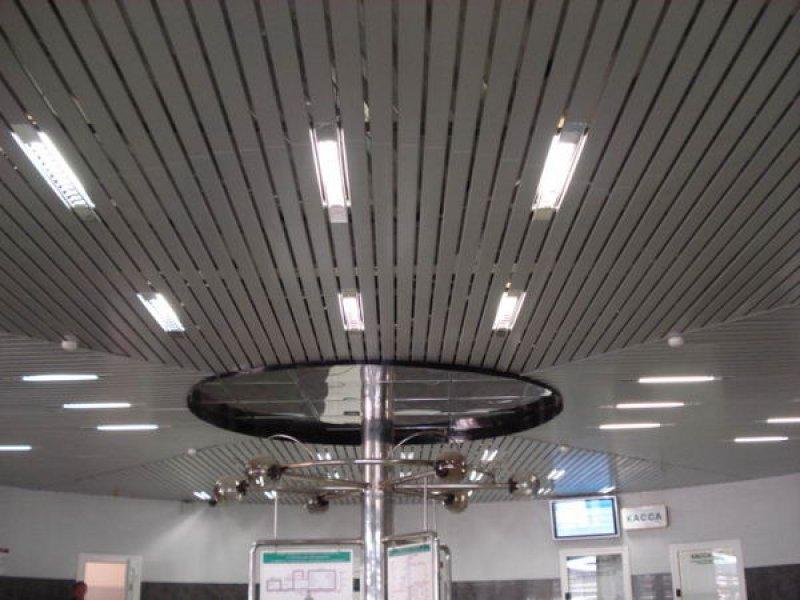
General rules for installation
The installation of light fixtures in a slatted ceiling will provide convenience and comfort, if you adhere to the rules:
- If spot models will be the main lighting in the room, the number is determined on the basis of 1 fixture per 2 sq.m. area.
- It is important to study the technical characteristics of the light source to ensure uniform lighting.
- Making a scheme of placement of individual modules should be taken into account along with the beauty of the light composition and its functional value. It is important to determine the intensity of lighting of individual areas of the room. It is required differently: more powerful for the dining area, weaker for the recreation area, etc.
- Even before the slatted frame is installed, make a wiring diagram and connect electrical wires to each light module. It is unlikely you will be able to fix anything after installation without destroying the individual elements of the construction.
The installation process of an aluminium rack and pinion ceiling with light lines.
Caution should be exercised when installing halogen lighting elements, as they become very hot when in operation. This feature can lead to adverse effects on the suspended material, such as deformation of the plastic panels.
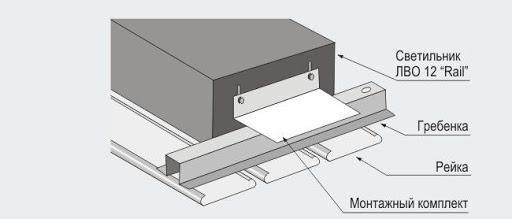
Tools and materials for installation
Installation of any electrical appliances is better to entrust to professionals, Such work requires special knowledge and skills. But if there is no way out, then with confidence and preparation the installation can be carried out independently. The first thing you should definitely study the instructions to the fixtures, there should be a scheme of their assembly and installation.
Before starting to install the fixtures in a slatted ceiling, you need to prepare tools and materials:
- tape measure to a length of at least 4 m, a ruler;
- caliper, pencil;
- jigsaw and power drill with a set of drill bits of different diameters;
- construction level;
- hammer, screwdriver, knife, scissors;
- hacksaw blade for cutting metal;
- dowels, bolts, screws;
- mounting metal profile;
- duct tape;
- step-ladder.
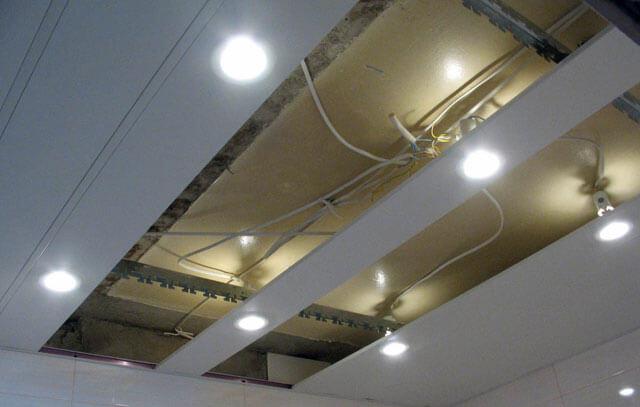
Fixing technology
The installation of lighting fixtures on a suspended grid ceiling is carried out in the following order.
- On the base ceiling is laid electrical wiring according to the scheme, with leads to each light module. It is best if it is placed in special corrugated tubes - this will facilitate its fixing, increase reliability and operational safety.
- On the previously marked sections of the rail with a drill with a drill bit make holes for the lamp housing.
- On the base ceiling, a frame of rails and studded metal profiles is attached with screws and hangers. The frame is lined with decorative panels (battens) from below. When fastening the profiles and laying the panels, take into account the location of the lamps.
- Check the coincidence of the mounting points of the lamps with the points of holes on the panels. Over the channels are installed thermal rings, they insulate the panel from the effects of temperature when the lighting fixture heats up.
- It is important to make accurate holes with the exact diameter for the lamps. To do this, it is better to use an electric jigsaw or, alternatively, a sharp knife. To make the sockets inconspicuous, they should be made with a diameter slightly smaller than the size of the light module.
- For rooms with a variable humidity (kitchen, bathroom) use lights with special plafonds with a waterproof seal.
- Each lamp separately connect to the common wiring through a special terminal block. It is not allowed to make a serial connection from lamp to lamp. If the ceiling area is large, you need to place a separate junction box near a particular group of fixtures.
The overall composition of ceiling fixtures can be well supplemented by the installation of side decorative lighting modules on the walls under the ceiling.
